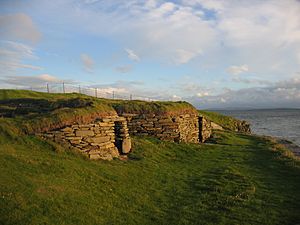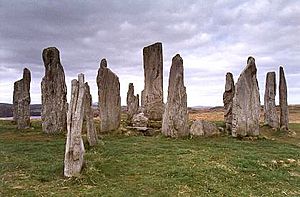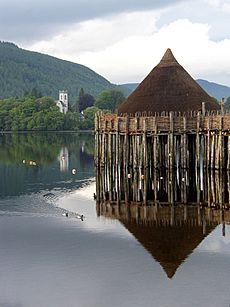Architecture of Scotland in the prehistoric era facts for kids
The architecture of Scotland from prehistoric times includes all the buildings made by people within what is now Scotland, before the Romans arrived in Britain around the first century BCE. Stone Age settlers started building with wood in Scotland at least 8,000 years ago. The first permanent stone houses were built about 6,000 years ago. Great examples are Knap of Howar in Orkney and the village of Skara Brae.
During this time, people also built many chambered tombs and cairns, especially in the west and north of Scotland. In the south and east, there were earthen barrows, which were often connected to wooden structures that have mostly disappeared. Other related buildings included bank barrows, cursus monuments, mortuary enclosures, and large timber halls.
In the Bronze Age, fewer new buildings were made. However, we find crannogs, which were roundhouses built on artificial islands. There were also Clava cairns and the first hillforts. By the Iron Age, people built strong stone Atlantic roundhouses, including tall broch towers and smaller duns. About 1,000 hillforts were built in Scotland, mostly south of the Clyde-Forth line.
Stone Age Buildings

The oldest known house in Britain was an oval wooden structure found at South Queensferry near the Firth of Forth. It dates back to the Mesolithic period, around 8240 BCE. The very first stone structures were probably three hearths found on Jura, from about 6000 BCE.
As farming began, people in the Neolithic era (around 6,000 years ago) started building stone houses in Scotland. The first villages appeared about 500 years later. Many Neolithic homes, burial sites, and special places are found in the Northern and Western Isles. This is because there weren't many trees there, so people used local stone for building.
The stone house at Knap of Howar on Papa Westray, Orkney, is one of the oldest surviving houses in north-west Europe. It was built using dry-stone (stones fitted together without mortar) and was likely lived in for 900 years, from 3700 to 2800 BCE. Skara Brae on the Mainland of Orkney is another famous site from this time. It was used from about 3100 to 2500 BCE and is Europe's most complete Neolithic village.
Many chambered tombs and cairns were also built during this period. These were graves made of stone. They can be grouped into passage graves, gallery graves, and stone cists. Cists are simple box-like graves made of stone slabs.
Maes Howe near Stenness on Orkney (3400–3200 BCE) and Monamore on the Isle of Arran (around 3500 BCE) are passage graves. These are megalithic, meaning they were built with very large stones, some weighing many tons. Gallery graves are rectangular, with an entrance at one end that is as wide as the gallery. These were sometimes lined or roofed with slabs and then covered with earth.
Some of the most impressive monuments from this time are the first standing stones in Scotland. For example, the Stenness on Orkney date from about 3100 BCE. There are four stones, and the tallest is about 4.9 meters (16 feet) high.

In the Highlands and Islands, stone was used a lot. But in the south and east, the most common Neolithic buildings that survive are earthen barrows. These probably started being built around 4000 BCE. Today, these are huge mounds of earth or stone, often shaped like a trapezoid and usually facing east. You can find them across the Lowlands, especially in Aberdeenshire, Angus, Dumfries and Galloway, and the Scottish Borders.
Other related structures include bank barrows, cursus monuments, mortuary enclosures, timber halls, and other types of enclosures. Bank barrows are long, parallel-sided mounds, usually with ditches on both sides. Cursus monuments also have long parallel banks of earth with ditches, but they create an open avenue or enclosed space between them. Both types are usually connected to burial chambers.
Examples of bank barrows in Scotland include the long mound at Auchenlaich in Perthshire and the Cleaven Dyke, which is a mix of a bank barrow and a cursus monument, stretching over 2.4 kilometers (1.5 miles). Mortuary enclosures are usually rectangular banks with outside ditches and raised platforms inside. Some experts think these were used to prepare bodies before burial elsewhere, but this is debated. Remains of these enclosures are often found under long barrows. Key examples are Pitnacree in Perthshire and two sites at Lochhill and Slewcairn in Kirkcudbright.
The timber halls are probably unique to Scotland. These were massive buildings with roofs, made of oak. All of them seem to have been burned down later. People still debate what these buildings were for. Some think they were regular farmhouses for Neolithic families, while others believe they were part of bigger, special constructions like barrows. The hall at Balbridie, Aberdeenshire, was 26 meters (85 feet) long and 13 meters (43 feet) wide. Its roof might have been 9 meters (30 feet) high, making it big enough for up to 50 people.
Bronze Age Buildings
When people started working with bronze around 2000 BCE, fewer large new buildings were constructed. This, along with less land being farmed, suggests that the population might have decreased.
From the Early and Middle Bronze Age, we find stone roundhouses made of connected cells, like those at Jarlshof and Sumburgh in Shetland. At Jarlshof, these were oval houses with thick stone walls. In the earliest times, they might have been partly underground, which helped make them stable and warm.
There is also evidence of crannogs being used. These were roundhouses built partly or entirely on artificial islands, usually in lakes, rivers, or tidal waters. They were often made of layers of brushwood and rubble. Sometimes, their edges were reinforced with vertical wooden piles and topped with oak logs.
People continued to build cairns and Megalithic monuments during this period. There are about fifty Clava cairns in Scotland, named after those near Inverness. They come in two main forms: circular stone enclosures called "ring cairns," or passage graves with a long entrance, often lined up with astronomical events.
Like in other parts of Europe, hill forts first appeared in Scotland during the Bronze Age. For example, Eildon hill near Melrose in the Scottish Borders was occupied from around 1000 BCE. It had hundreds of houses on a fortified hilltop. Traprain Law in East Lothian had a 8-hectare (20-acre) enclosed area, divided in two, made of a stone wall with a rubble core.
Iron Age Buildings
In the early Iron Age, starting from the seventh century BCE, the cellular houses on the northern isles began to be replaced by simple Atlantic roundhouses. These were strong circular buildings made of drystone. Important examples are found at Quanterness, Bu, Pierowall, and Tofts Ness on Orkney, and at Clickimin in Shetland. From about 400 BC, more complex Atlantic roundhouses started to be built, such as at Howe on Orkney and Crosskirk in Caithness.
The largest buildings from this era are the circular broch towers, which probably date from about 200 BCE. These are unique to Scotland and are drystone structures with hollow walls. Most ruins only stand a few meters above the ground, but five examples still have walls over 6.4 meters (21 feet) high. There are at least 100 broch sites in Scotland. The best preserved include those at South Yarrows near Wick, Midhowe Broch on Orkney, and the Broch of Clickimin and the Broch of Mousa in Shetland. Even after much research, their purpose and the societies that built them are still debated.
Since the 1960s, archaeologists have separated brochs from smaller, similar buildings, usually called duns. Crannogs were used most heavily in this era, but they continued to be used until the Middle Ages. This period also saw the beginning of wheelhouses. These were roundhouses with a special outer wall and a circle of stone piers inside (looking like the spokes of a wheel). However, they became most common during the time of Roman occupation.
There is evidence for about 1,000 Iron Age hillforts in Scotland, most located south of the Clyde-Forth line. Most are circular, with a single palisade (a fence of strong wooden posts) around an enclosed area. Most are quite small, covering one or two acres, but some are much larger, like Castle O'er, Birrenwark, Cadimuir, Cadroner, and White Meldon. They seem to have been mostly abandoned during the Roman period, but some appear to have been used again after the Romans left.
See also
- Oldest buildings in Scotland
- Timeline of prehistoric Scotland




